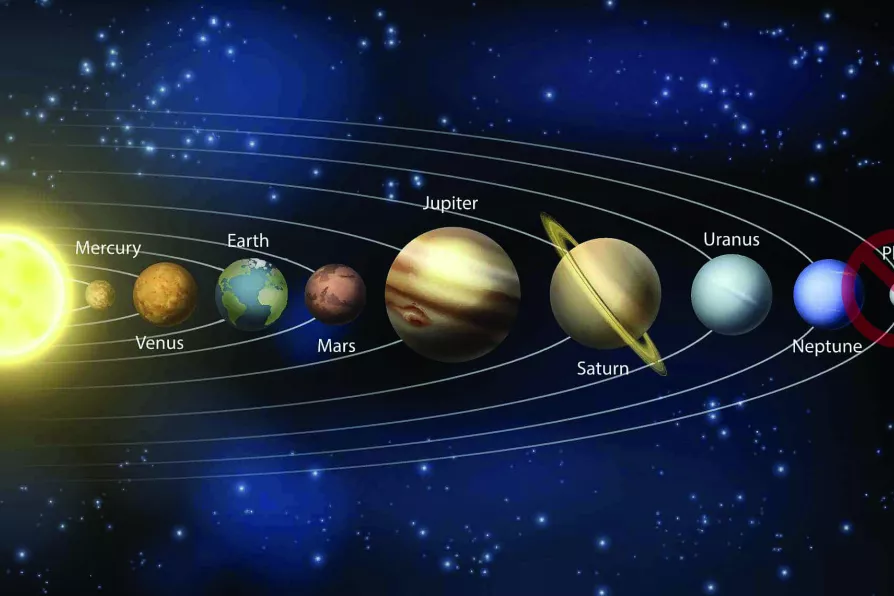KATE CLARK recalls an occasion when the president of the Scottish National Union of Mineworkers might just have saved a Chilean prisoner’s life


IN FEBRUARY 1930, the astronomer Clyde Tombaugh spotted what seemed to be a larger than usual object. It was moving in the Kuiper belt, a disc of small remnants left over from the creation of the Solar System that circle around the sun beyond the orbit of the planet Neptune.
Further photographs confirmed the discovery. In May of the same year the name Pluto was announced for the newest and smallest planet, bringing the total number of planets in our Solar System to nine.
The word “planet” derives from the ancient Greeks’ word for “wanderer.” They distinguished five planets that they could see with the naked eye (Mercury, Venus, Mars, Jupiter and Saturn) because they “wandered” across the background of the other points of light in the night sky — the stars — over the year.
Hiding among the “fixed” stars were Uranus and Neptune, which are often visible to the naked eye but whose slow orbits hid them from being recognised as planets until telescopes were powerful enough for people to notice their small changes in position.
The established process of adding newly discovered, relatively large celestial objects orbiting the Sun to the list of planets ran into trouble in the early 1990s. Scientists began to discover other large objects in the Kuiper belt that had similar characteristics to Pluto.
The first was the catchily named 15760 Albion, found in 1992. Although it was smaller than Pluto, it demonstrated that other objects were waiting to be discovered floating around beyond Neptune in the Kuiper belt.
In 2005 the discovery of Eris, which was initially thought to be larger than Pluto, blew the debate over what constitutes a planet wide open. Surely if Pluto counted as a planet, then Eris must be crowned the tenth planet.
However, if Eris was a planet, then why wasn’t Albion also a planet? And if Albion was a planet, then what about the hundreds of other similarly sized objects that were now regularly being discovered in the Kuiper belt?
The International Astronomical Union held a 10-day meeting in Prague to debate amongst its members and decide on the official definition of a planet.
After several draft proposals they decided that a planet “is a celestial body that a) is in orbit around the Sun, b) has sufficient mass for its self-gravity to overcome rigid body forces so that it assumes a hydrostatic equilibrium (nearly round) shape and c) has cleared the neighbourhood around its orbit.”
This definition meant that neither Pluto, Eris, nor Albion were planets since they had not “cleared their neighbourhood.” This refers to how the gravitational forces exerted by objects with sufficient mass make other smaller objects around them come towards and eventually collide with them, orbit around them as a satellite, or leave the neighbourhood on an altered trajectory.
As of August 2006, Pluto was reclassified as a “dwarf planet.” Dwarf planets meet criteria a) and b) above but have not cleared their neighbourhood. They are also not themselves orbiting another planet or dwarf planet (like a moon).
The reclassification was not happily received in all circles. A satirical resolution, nevertheless backed by 52 other members of the California State Assembly with varying levels of credulity, denounced the decision and claimed that the change would “cause psychological harm to Californians who question their place in the universe and worry about the instability of universal constants.”
Although intended by its originators as a joke, this quote identifies the problem many of us face when “facts” change in science, not through new evidence, but through new analysis.
To those of us who were told there were nine planets in school as if it was non-negotiable, this is confusing. If we think that facts are revealed truths of the universe, how can they change? But if we think that facts are arbitrary human constructions, what’s the meaning of scientific truth at all?
Any Californians worrying about the instability of universal constants would be able to take little comfort in knowing that the property of being a planet or not was never a constant.
The idea has been derived by ancient cultures across the globe from points of light moving across the sky. Although identifying them required detailed and expert knowledge of the stars, understanding the character of the celestial objects themselves was constrained by the capacity of the naked eye and later early iterations of Earth-bound equipment for stargazing.
The discovery of Pluto, which is not visible without a telescope, was made possible by new technology. This new information indicated that it shared characteristics with the known planets.
As stargazing technology advanced even further however and more objects were discovered, the original concept of a planet was no longer proving useful.
People had grown used to a list of planets that could be counted on two hands, an important fact about the Solar System. Now it appeared either that there were thousands of planets, most of which were tiny (which goes against many people’s intuition of what a planet should be), or being a planet requires some size threshold.
That threshold could have been drawn arbitrarily to include Pluto, but in this case it was chosen based on a characteristic of large objects: the ability to absorb nearby asteroids and clear its own orbit. However, note that this definition is still relatively fuzzy and remains a matter of debate. Using this definition, Pluto is more like the not-planets than the things that had previously been called planets.
The concept of a planet does not exist outside of the human enterprise of categorising and understanding the world we live in. However, there are definitely many lumps of matter moving around the sun. Objects in our Solar System have properties such as size and mass — and it is these characteristics that we use to divide them into groups in ways that are useful to help our understanding of the universe. These facts are socially constructed.
To say that the concept of a planet is “socially constructed” in this way does not clash with the philosophical stance of materialism. Those small objects in the Kuiper belt exist and go on hurtling around regardless of whether they meet our latest definition of a planet or not.
However, celestial bodies are not categorised by nature. This is an entirely human activity as the International Union of Astronomers demonstrated in Prague in 2006.
The social construction of facts does not mean that the category “planet” cannot be meaningful. Both the old and new definition of planet are socially constructed and both hold meaning for some people. Moreover, nothing magical or incomprehensible has occurred when some facts are constructed in opposition to others.
Nothing material has changed, but the facts, depending on your point of view (and this is where the ideology can sleep), can help you understand the material reality better, worse, or merely in different ways.
As science continues, there may be further discoveries or analyses that warrant further reconsideration of what a planet is. For example, it is hard to apply the same criteria for being a planet outside of our Solar System. We often detect “exoplanets” far outside our Solar System indirectly, by their effect on other celestial bodies. They are so far away we cannot (yet) easily determine if they have cleared their neighbourhood.
Several mathematical equations have been derived to act as criterion for whether a body will clear its orbit or not depending on properties such as its mass, but even this isn’t always known well for exoplanets.
While technological changes might make this analysis possible in the future, another possibility is that the definition of a planet might be updated to make the notion of neighbourhood clearing more precise. Or perhaps it will be abandoned altogether for a different definition.
This continual process of refining and expanding our concepts and theories for the material world we live in is the enterprise of science. In the 19th century, Engels described the work of previous scientific advances as “the analysis of nature into its individual parts, the grouping of different natural processes and objects in definite classes.”
But he cautioned against seeing these groupings as eternally fixed: “This method of work has also left us as legacy the habit of observing natural objects and processes in isolation, apart from their connection with the vast whole; of observing them in repose, not in motion; as constraints, not as essentially variables.”

The distinction between domestic and military drones is more theoretical than practical, write ROX MIDDLETON, LIAM SHAW and MIRIAM GAUNTLETT

Nature's self-reconstruction is both intriguing and beneficial and as such merits human protection, write ROX MIDDLETON, LIAM SHAW and MIRIAM GAUNTLETT

A maverick’s self-inflicted snake bites could unlock breakthrough treatments – but they also reveal deeper tensions between noble scientific curiosity and cold corporate callousness, write ROX MIDDLETON, LIAM SHAW and MIRIAM GAUNTLETT
Science has always been mixed up with money and power, but as a decorative facade for megayachts, it risks leaving reality behind altogether, write ROX MIDDLETON, LIAM SHAW and MIRIAM GAUNTLETT













